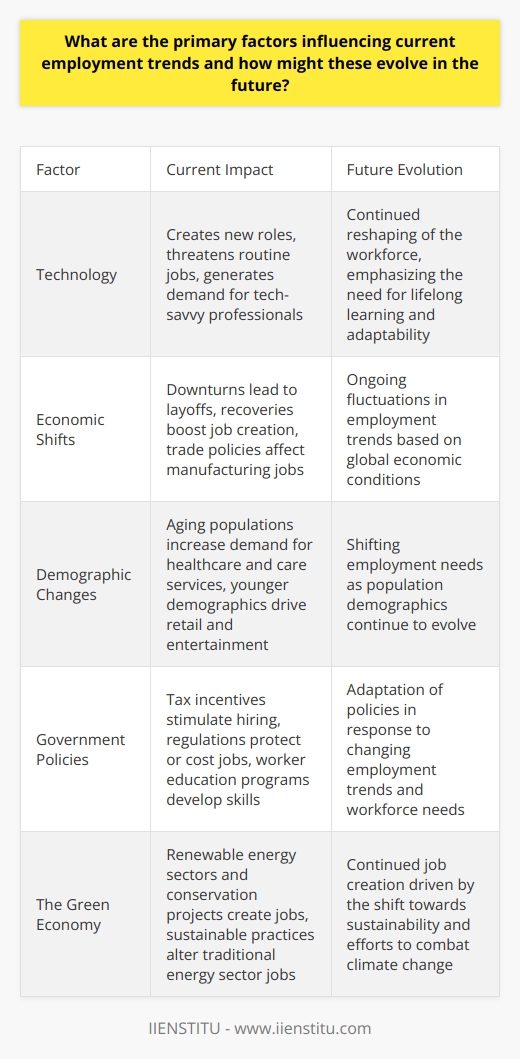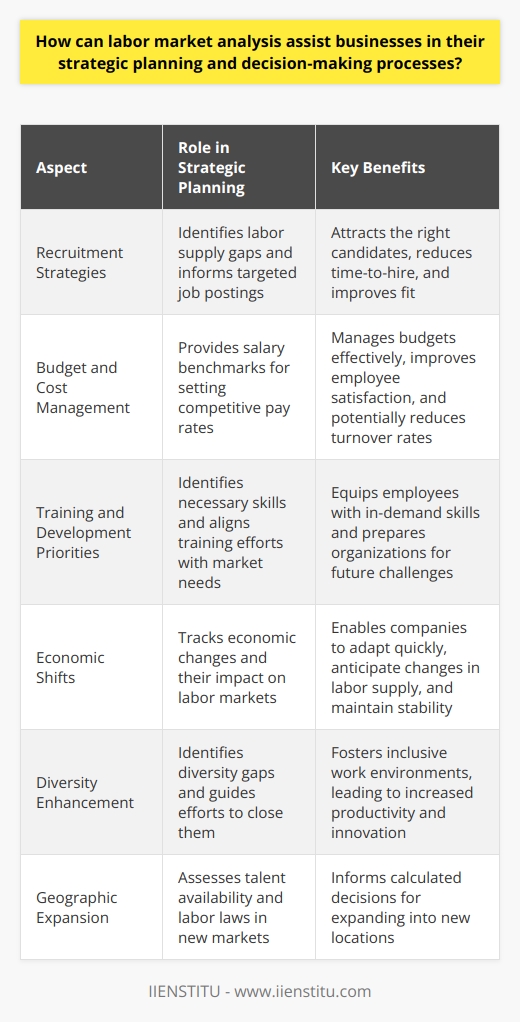
In an ever-evolving economic landscape, the ability to examine and interpret employment trends through labor market analysis remains a pivotal skill for policymakers, businesses, and individuals alike. This analytical process aids stakeholders in understanding various facet of employment, from job creation to wage patterns within a specific geographic or industry sector.
As we delve into the nuances of labor market analysis, it is essential to recognize its capacity to guide informed decisions and anticipate future shifts in the job market. Herein we shall explore the sophisticated world of labor market analysis, its methodologies, implications, and practical value to various levels of economic participants.
Understanding Labor Market Analysis
Labor market analysis is an invaluable tool that provides insights into the complexities of the employment sector. By examining the interplay between the supply (workers) and demand (jobs) within the labor force, experts can draw significant conclusions about the economic well-being of a region or sector.
Definition of Labor Market Analysis
Labor market analysis is a multifaceted approach to understanding employment trends within a particular geography or industry. This analysis encompasses a wide range of data points, including employment rates, skill requirements, wage levels, and employer demands.
Key elements of labor market analysis involve dissecting these data sets to ascertain how various sectors are performing, where job growth is occurring, and what skills are necessary for the evolving workforce.
Purpose and Objectives of Labor Market Analysis
Fundamentally, the purpose of labor market analysis is to achieve a prosperous balance between labor supply and demand. Its objectives are tailored to provide a granular understanding of the workforce and economic environment. Specifically, identifying trends and changes in the labor market enables stakeholders, from government entities to educational institutions, to align their strategies with market realities, ensuring better outcomes for job-seekers and employers alike.
Application of Labor Market Analysis in various sectors
Labor market analysis applies across all sectors of the economy. In retail, for example, analysis might reveal an increasing demand for e-commerce professionals due to the shift from in-store shopping to online.
Conversely, in manufacturing, labor market analysis might indicate a growing need for automation technicians as companies incorporate more robotics into their processes. These examples underscore the practical relevance of labor market analysis, informing decisions about training programs, recruitment strategies, and investment opportunities.
Steps in Conducting Labor Market Analysis
A systematic approach to labor market analysis enables stakeholders to craft strategic decisions rooted in empirical data. This process involves several critical steps, from identifying the specific market to collecting and scrutinizing relevant data.
Identification of Labor Market
The foundation of labor market analysis is establishing the boundaries of the market under review. This can be determined by geographical boundaries, such as a city, region, or country, or by occupational or industry boundaries, focusing on specific sectors like technology, healthcare, or finance. Defining the scope of the labor market is crucial to targeting analysis effectively.
Gathering and Analyzing Labor Market Information
Once the market is defined, the next step is to collect pertinent information. Primary data might come directly from surveys and interviews, offering fresh and specific insights, whereas secondary data could involve existing research, reports, and statistics from government or academic sources. Together, these data streams form a comprehensive picture of the labor market landscape.
Understanding Labor Market Indicators
Labor market indicators are key statistics that provide a snapshot of economic performance. These include metrics such as the unemployment rate, job vacancy rates, and median earnings. Understanding these indicators and their significance enables a thorough comprehension of market conditions, including the identification of trends that can profoundly impact employment prospects.
Benefits and Limitations of Labor Market Analysis
The insights derived from labor market analysis can be transformative for numerous stakeholders when utilized effectively. However, these benefits are often constrained by inherent limitations within the process.
Benefits of Labor Market Analysis
In terms of benefits, labor market analysis can inform policy-making, ensuring that labor regulations and economic strategies are based on current industry needs. Furthermore, it supports facilitating career decision-making among job-seekers, guiding them to in-demand roles that match their skill set. For businesses, it plays a critical role in enhancing recruitment and retention strategies, enabling employers to attract and maintain a competent workforce.
Limitations of Labor Market Analysis
Despite these advantages, labor market analysis also encounters challenges. At times, there may be limitations in data, such as outdated information or incomplete data sets. Additionally, the complexities of labor market dynamics mean that swift changes in technology, globalization, and economic forces can quickly render previous analysis less relevant.
Predicting future labor trends is an ongoing challenge as it involves extrapolating from current data and trends which may not always capture emerging changes.
Case Study: A Successful Labor Market Analysis
Even with complexities and limitations, labor market analysis can result in significant strategic success for organizations. A well-documented case study will illustrate the concrete benefits of this analytical process.
Description of the Company
Consider a mid-sized technology firm seeking to expand its product offerings. With a well-established base in software development, the company is eyeing the burgeon cloud services market.
The Need for Labor Market Analysis
To understand the labor needs for this strategic pivot, the company recognizes the necessity of a thorough labor market analysis to guide its hiring and training initiatives.
The Process Undertaken for the Analysis
The analysis commenced with a comprehensive review of the current labor force, required skill sets, and projections for future demand within the cloud services sector.
Key Findings and How They Were Used
The company discovered a significant demand for security and infrastructure specialists able to manage large-scale cloud deployments. It then utilized these findings to develop tailored online certification courses and recruit personnel with these specific competencies.
Outcome and Impacts
The focused approach facilitated by labor market analysis allowed the company to effectively reallocate resources, leading to a successful market entry and increased profitability.
In summary, labor market analysis serves as a critical barometer for the health and direction of employment sectors. Its efficacy in shaping effective strategies for workforce development, economic policy, and business operations cannot be overstated. As today's world becomes more dynamic and technologically driven, the importance of labor market analysis only grows, prompting a continued need for its application and refinement.
Consequently, it is essential that individuals and organizations alike stay abreast of labor market trends, seeking further education through avenues like human resources course to maintain and enhance their analytic capabilities. Regardless of one's role in the economy, a firm grasp of labor market analysis promises a more informed and strategic approach to the future of work.
Frequently Asked Questions
What are the primary factors influencing current employment trends and how might these evolve in the future?
Understanding Employment Trends
Employment trends reflect complex interactions. Several factors influence them.
Technology
Technological advancements reshape job markets. They create new roles. They also make some obsolete. Automation threatens routine jobs. However, technology generates demand for tech-savvy professionals.
- AI impacts service industries.
- Robotics transform manufacturing.
- Remote work software spikes in demand.
Economic Shifts
Global economic shifts cause employment trends to fluctuate. Downturns often lead to layoffs. Recoveries can boost job creation.
- Trade policies affect manufacturing jobs.
- Economic crises lead to workforce cuts.
- Recovery periods see hiring surges.
Demographic Changes
Population changes also play a role. Aging populations affect healthcare jobs. They increase demand for care services.
- Older populations may extend working years.
- Younger demographics drive retail and entertainment.
- Migration patterns can fill or create labor gaps.
Government Policies
Policies set by governments shape employment. Tax incentives can stimulate hiring. Regulations can protect or cost jobs. Worker education programs can develop skills.
- Subsidies can promote certain industries.
- Minimum wage laws impact job structure.
- Education initiatives target future skill sets.
Seasonal Variations
Jobs often depend on the season. Tourism peaks affect hospitality employment. Agricultural roles vary with harvest times.
- Winter months can slow construction.
- Summer boosts tourism-related jobs.
- Agricultural jobs peak in harvest season.
The Green Economy
The shift towards sustainability creates jobs. Renewable energy sectors are growing. Conservation projects also employ many.
- Solar power drives job creation.
- Electric vehicles lead to new manufacturing jobs.
- Sustainable practices alter traditional energy sector jobs.
Future Evolution
These trends will continue to evolve. Technology will keep reshaping the workforce. Demographics will shift employment needs. Governments will adapt policies in response.
- Lifelong learning will become crucial.
- Flexible work will likely persist.
- Climate change will impact job creation.
Workers need adaptability. Skills development will become essential. Understanding these factors allows for better job market navigation. The future holds promise for those who adapt.

How can labor market analysis assist businesses in their strategic planning and decision-making processes?
Understanding Labor Market Analysis
Labor market analysis examines the supply and demand for workers. It aligns workforce capabilities with business goals.
Role in Strategic Planning
Strategic planning needs data. Labor market analysis offers this. Companies seek insights for decision-making.
Decision-Making Processes Enhanced
Decisions rely on labor market trends. Skills shortages inform training investments. Companies learn where competition for talent lies.
Key Benefits of Labor Market Analysis
Labor market analysis assists in many ways. Here are key benefits.
Informed Recruitment Strategies
Recruiters face challenges in finding talent. Analysis reveals labor supply gaps. Businesses craft targeted job postings accordingly.
Recruitment becomes strategic, not reactive. Companies attract the right candidates. They reduce time-to-hire and improve fit.
Budget and Cost Management
Salary benchmarks come from labor market data. Companies set competitive pay rates. They manage budgets better.
Compensation strategies stem from this. Employee satisfaction often improves. Turnover rates may decline.
Training and Development Priorities
Skills gaps pose threats to growth. Analysis identifies necessary skills. Companies focus training efforts better.
They match development programs with market needs. Employees gain in-demand skills. Organizations prepare for future challenges.
Navigating Economic Shifts
Economic changes impact labor markets. Analysis tracks these shifts. Companies adapt to new conditions quicker.
They anticipate changes in labor supply. They prepare for economic downturns or booms. Strategy adjusts to maintain stability.
Enhancing Diversity
Diverse workforces offer benefits. Analysis helps identify diversity gaps. Companies work to close these.
They recruit from underrepresented groups better. Work environments become inclusive. Productivity and innovation often rise.
Expanding Geographically
Companies consider new markets for expansion. Labor analysis guides these decisions.
They assess talent availability in new locations. They learn about local labor laws. Expansion becomes informed and calculated.
Conclusion
Labor market analysis proves crucial for business strategy. It provides a data-driven foundation for decision-making.
An informed approach leads to smarter strategies. It aligns workforce development with business objectives. Companies gain competitive advantages. They adapt to changing environments with confidence.
In essence, labor market analysis is a strategic tool. It empowers businesses to build a resilient and skilled workforce. The outcomes? Enhanced performance and sustained growth.

What role does technology play in shaping and predicting labor market trends?
Technology and Labor Market Trends
Defining the Labor Market Landscape
Technology molds the modern labor market landscape. It revolutionizes job creation and destruction. New sectors emerge, old ones fade. Artificial intelligence and automation exemplify this transformation. They bring new productivity levels. But they also displace traditional manual work.
Tech influences labor market dynamics substantially. It affects how employers and employees connect. Online platforms facilitate globalized freelancing. Remote work becomes a standard option. Diverse opportunities arise, transcending geographical boundaries.
Predictive Analytics and Labor Forecasts
Predictive analytics tools transform labor market forecasting. Data analytics anticipate skills demand. Machine learning algorithms parse vast job market data. They identify emerging trends quickly. Employers gain insights to strategize talent acquisition.
Technology assesses skill gaps in real-time. Companies can adapt their workforce plans accordingly. Workers can upskill or reskill proactively. Educational institutions adjust curricula to meet future demands.
Shaping Labor Market Trends through Innovation
Innovation drives labor market evolution. Startups introduce novel business models. They disrupt established markets and employment norms. Tech companies often set new workplace standards. They champion flexible hours and remote work.
Traditional industries incorporate technology gradually. Manufacturing adopts robotics. Retail moves towards e-commerce. Even farming sees precision agriculture. Each sector’s workforce must adapt.
Staffing and recruitment use technology extensively. AI streamlines candidate matching and selection processes. Digital outreach methods diversify recruitment. Job seekers access global opportunities with a click.
The Challenges and Opportunities of Technological Influence
Challenges arise with technological impact. Job displacement generates social concerns. Tech development outpaces regulatory frameworks. Governments and organizations must collaborate. They need to ensure ethical standards and workforce protections.
Opportunities abound through tech change. Tech spawns new roles. It champions unheard-of careers. The gig economy grows, powered by digital platforms. Lifelong learning becomes a staple. Technology empowers workers to weather market shifts.
Preparing for the Future of Work
Preparation strategies are pivotal. Continuous education ensures workforce relevance. Policy adjustments support displaced workers. Public-private partnerships are critical. They bridge the gap between current skills and future needs.
Collaboration between education sectors and industry is vital. They co-create relevant training programs. They secure the future employability of students. Lifelong learning platforms emerge. They offer agile skill development.
Conclusion
Technology sits at the labor market's core. It shapes, predicts, and often disrupts. Employers leverage tech to strategize. Employees use it to advance. Society faces the double-edged sword of tech influence. It offers countless opportunities yet presents challenges requiring nimble adaptation and foresight.



